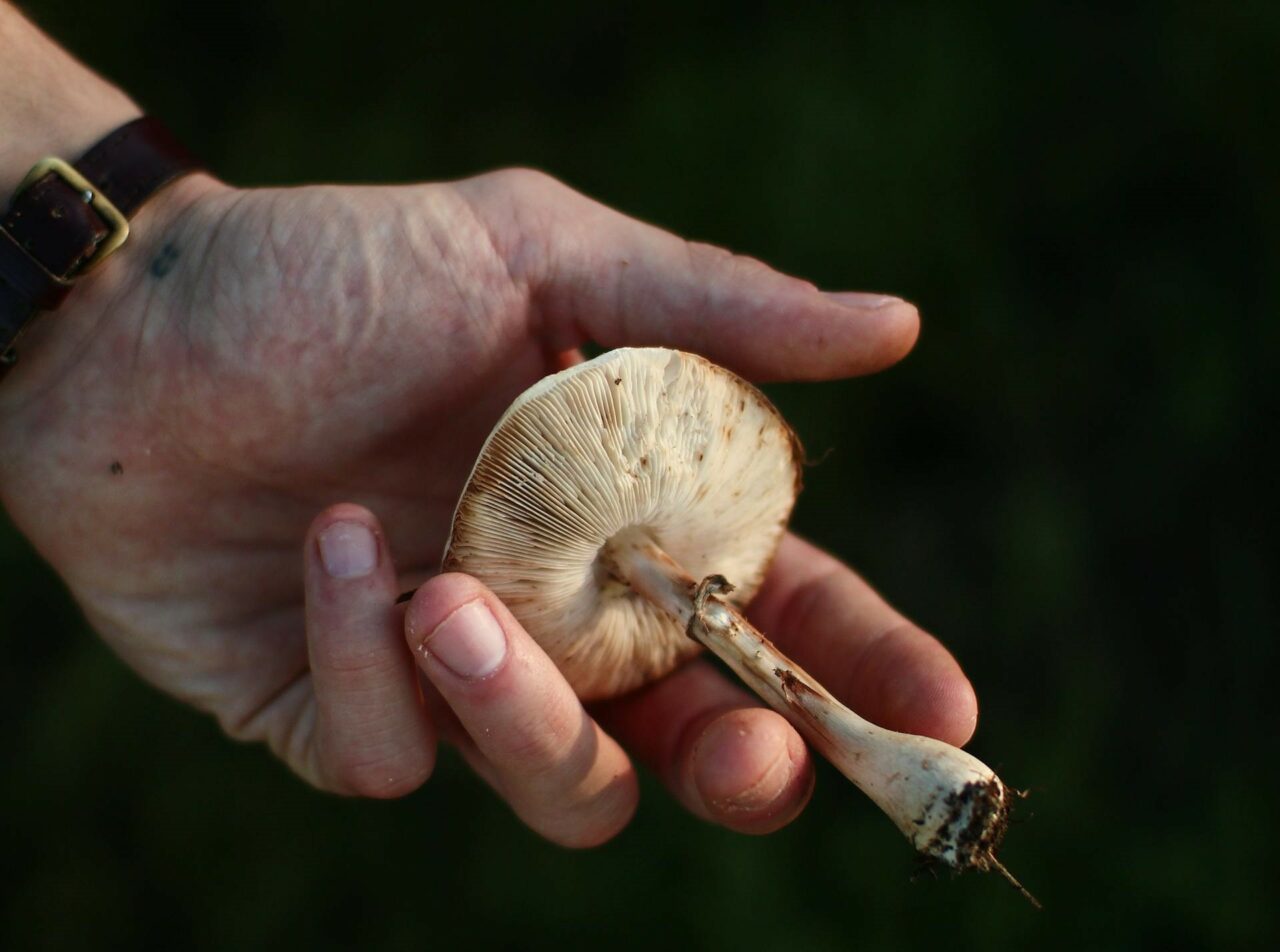Psilocybin mushrooms, a traditional psychedelic similar to LSD in terms of their serotonin 5-HT2A receptor agonist activity, are currently under investigation for their potential in psilocybin-assisted therapy. The focus is on mental health disorders such as major depression, anxiety, emotional distress, cluster headaches, and migraines.
In order to understand how shrooms are beneficial for these conditions, it is essential to examine their metabolism process within the body. This knowledge is crucial for both researchers and users to interpret how the active compound induces psychological and therapeutic effects. This article offers a basic understanding of the pharmacology and pharmacokinetics of psilocybin.
[toc]
Key Takeaways:
- When psychedelic fungi are consumed orally, half of them are absorbed and distributed throughout the body.
- The compound in the fungi undergoes dephosphorylation through the enzyme alkaline phosphatase, mainly in the liver.
- Around 3.4% of the compound is expelled in its original form within 24 hours, with most of it being eliminated as a stable metabolite.
What is Pharmacokinetics?
Pharmacokinetics (PK) is the scientific study of how substances, such as drugs, are processed by the body once they are ingested. It is related to, but distinct from, pharmacodynamics, which explores how a compound interacts with the body. PK focuses on four main areas: absorption, distribution, metabolism, and excretion (ADME).
Comprehending these processes enables healthcare professionals to recommend the most effective medications with the least risk. It also allows them to customize treatments according to each patient’s specific physiology and lifestyle.
How is Pharmacokinetics Relevant to Psilocybin?
Psilocybin and psilocin, the principal active compounds in certain magic mushroom species, have attracted significant attention from both researchers and users. Pharmacokinetics provides insights into how the body metabolizes these mushrooms, thereby aiding in understanding their potential medicinal or recreational effects.
Often referred to as “magic,” “psychedelic,” “medicinal,” or “sacred,” these compound-containing fungi are consumed, and The Varieties of mushrooms, their origin, size, growth and drying conditions, and age can significantly influence their potency levels.
While these mushrooms naturally grow in the wild, scientific advancements have enabled their lab synthesis. Both natural and lab-grown mushrooms exhibit low toxicity, but may occasionally cause minor side effects like nausea and vomiting.
Despite the minor physical side effects, the compounds in these mushrooms have demonstrated potential therapeutic advantages due to their safety and non-addictive characteristics. This has encouraged researchers to explore their applications in psychotherapy, particularly for treating anxiety and depression.
The Four Phases of Pharmacokinetics
Psilocybin, the active compound in these mushrooms, is initially inactive. It serves as a prodrug that transforms into its active form, psilocin, with the help of enzymes like alkaline phosphatase. This transformation facilitates psilocin’s absorption and distribution throughout the body, reaching various tissues. However, after oral intake, psilocybin remains undetectable in the circulatory system, feces, or urine.
Absorption
Absorption is the process through which the compound enters the bloodstream from the point of administration. It dictates how quickly and effectively the compound reaches its target, such as the plasma. Oral intake is the most common form of administration. Inhalation has been tested, but it proves less effective than oral consumption.
The absorption process also encompasses the discharge of the compound from the dosage form during oral ingestion. Factors like delays in the throat or esophagus can affect this, potentially slowing down the results or causing irritation. Once the compound arrives in the stomach, the acidic environment can start to break it down before entering the bloodstream.
Animal studies have shown that only about half of the orally administered psychedelic compounds are absorbed and distributed throughout the body.
Factors Affecting the Absorption Process
Several factors can influence the absorption process, leading to variations in the onset, intensity, and duration of effects:
- Stomach Contents: The presence of food in the stomach can delay absorption as it slows the onset of effects. An empty stomach allows for quicker absorption.
- Body Fat: Substances may accumulate in fat tissues, potentially prolonging their effects.
- Age: Metabolic rates and body composition can vary with age.
- Zero-Order Kinetics: This method removes the substance at a steady rate, irrespective of its concentration.
- First-Order Kinetics: Here, the elimination rate is directly proportional to the concentration of the substance.
Dispersion refers to how psilocin spreads in the body once it enters the bloodstream. Psilocin, being lipophilic, can permeate the blood-brain barrier and reach the central nervous system.
system.Several factors such as the size, polarity, and protein-binding capacity of the substance, and individual’s physiological conditions such as hydration status and body composition, significantly influence this process.
The goal is to ensure an effective concentration at the target location. For effectiveness, the substance needs to reach the intended area, as defined by the volume of distribution, and remain unbound to proteins, which allows it to actively interact with its receptor.
What Factors Affect the Dispersion Process?
Several factors can impact the dispersion process:
Typically, effects start to manifest between 20-40 minutes after ingestion, reaching a peak around 80-100 minutes. The effects of magic mushrooms generally last between 4-6 hours.
How is Dispersion to the Brain Achieved?
An initial experimental study on two species showed that its binding affinity follows this order: 5HT2A > 5HT1A > 5HT2B [23]. Psilocin also binds to dopamine D1, 5HT1E, 5HT5A, 5HT7, 5HT6, D3, 5HT2C, and 5HT1B receptors.
As a partial agonist at the 5HT2A receptor, its efficacy is around 40%. The psychedelic effects are likely due to its partial agonist activity at 5HT1A autoreceptors.
The mood-enhancing and psychotomimetic experiences may be related to the observed association between increased dopamine levels and sensations of depersonalization and euphoria. Hallucinogens work by modifying neurochemistry and receptor activity. They enhance 5HT2A agonist activity by boosting BDNF synthesis in the hippocampus, which promotes neurogenesis and reduces conditioned fear-related behaviors.
Elimination
Elimination refers to the process by which the The human body expels substances through various organs including the kidneys, lungs, skin, and gastrointestinal tract. With respect to kidneys, they filter out a naturally occurring psychedelic substance in the glomerulus or secrete it in the tubules. This process is complicated by some reabsorption.
The primary substance has a half-life of about 160 minutes, whereas psilocin’s half-life is roughly 50 minutes. Animal studies indicate that this is mostly expelled through urine, which accounts for approximately 65% within 8 hours of consumption. Even after that, remnants of the substance can be detected in smaller quantities in bile and feces.
In humans, about 3.4% of the substance is expelled in its original form within 24 hours, while most of it is eliminated as psilocin-O-glucuronide, a more stable metabolite. This stability allows for the substance to be detectable in urine samples over a longer duration.
There are two main methods for substance excretion:
Most psychedelic substances follow the first-order kinetics method, reaching steady-state concentrations after four to five half-lives. The substance is completely eradicated after the same duration of half-lives.
Discover Our Range of Hallucinogenic Mushrooms
The metabolic process differs among various types of fungi. By purchasing from reliable online suppliers like Shroomland Canada, you can prevent unintentional consumption of poisonous mushrooms. Some varieties, like Agaric mushrooms, can cause strong and undesirable effects. Therefore, it’s essential to obtain magic mushrooms from credible dispensaries instead of uncertain street vendors or wild foraging.
| Feature | Enigma | Full Moon Party | Gold Member | |
| Strain Type | Psilocybe Cubensis OMNI | Psilocybe cubensis (Thai Koh Samui) | Psilocybe cubensis | |
| Potency | Exceptionally high; 3.8% tryptamine content | Moderate to high potency | High potency | |
| Visual Characteristics | Resembles a blob or | Resembles a cauliflower or brain | Classic cubensis look; of average size | Robust white stems; golden caramel tops; distinctive blue discoloration |
| Effects | Considered the strongest; yields profound effects | Powerful cerebral high; delayed onset with marked visuals | Intense visuals and euphoria |
Educate Yourself on Psilocybin Mushroom Usage Online
For medical practitioners, researchers, and users, understanding the pharmacokinetics of shrooms is crucial. This comprehension aids in making informed decisions about dosage and timing, thus reducing possible risks.
Discover your perfect psychedelic journey at Shroomland Canada. Whether you’re after a soothing trip or a more significant exploration, our broad product line is tailored to meet your unique requirements. Experience superior, safe, and quality-regulated shrooms, eliminating worries over unreliable sources or poisonous mushrooms.
Enjoy the best magic mushrooms Canada provides and take your psychedelic adventure to new heights.
Frequently Asked Questions
Are there any known interactions between shrooms and other drugs?
Our products may interact with certain medications, particularly those that affect serotonin levels such as SSRIs (Selective Serotonin Reuptake Inhibitors). SSRIs and SNRIs (Serotonin and Norepinephrine Reuptake Inhibitors) usually reduce the effects, unlike non-serotonergic antidepressants. This reduced effect can last up to three months after you stop using the antidepressant.
Do all psychedelics operate in the same way as psilocybin?
No, each psychedelic substance has a unique structure that requires different metabolic processes to activate, and they attach to different receptors in the body. The mode of administration also affects the absorption of each psychedelic. While the basic principles of absorption, metabolism, and distribution are the same, the specific pathways and effects vary with each substance.
Can the form of the shroom affect the pharmacokinetics?
Yes, the form (fresh, powdered, or dried mushrooms) can influence the absorption speed. For example, powdered forms could be absorbed faster than whole dried ones due to quicker dissolution.
Suggested Reads:





